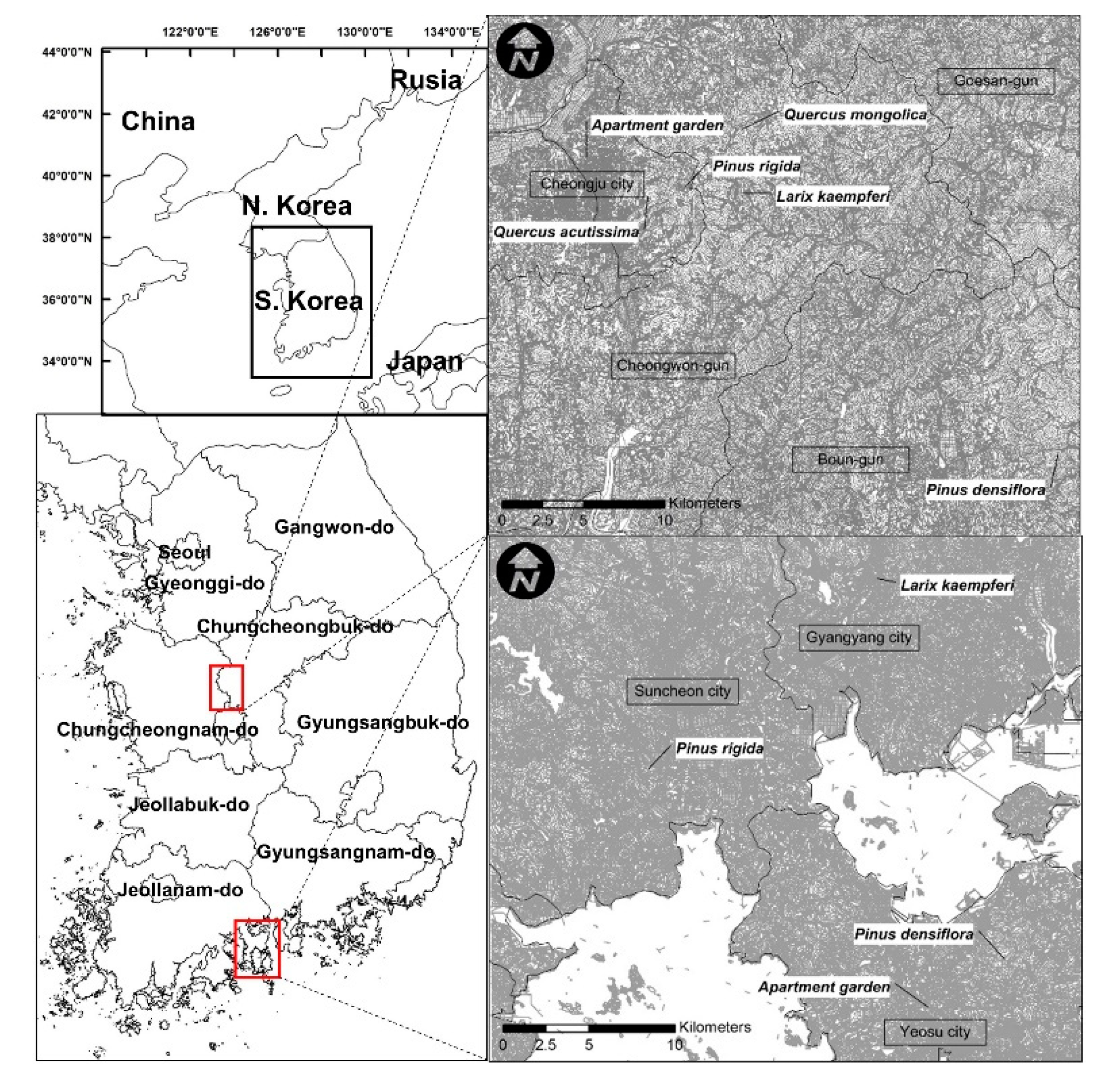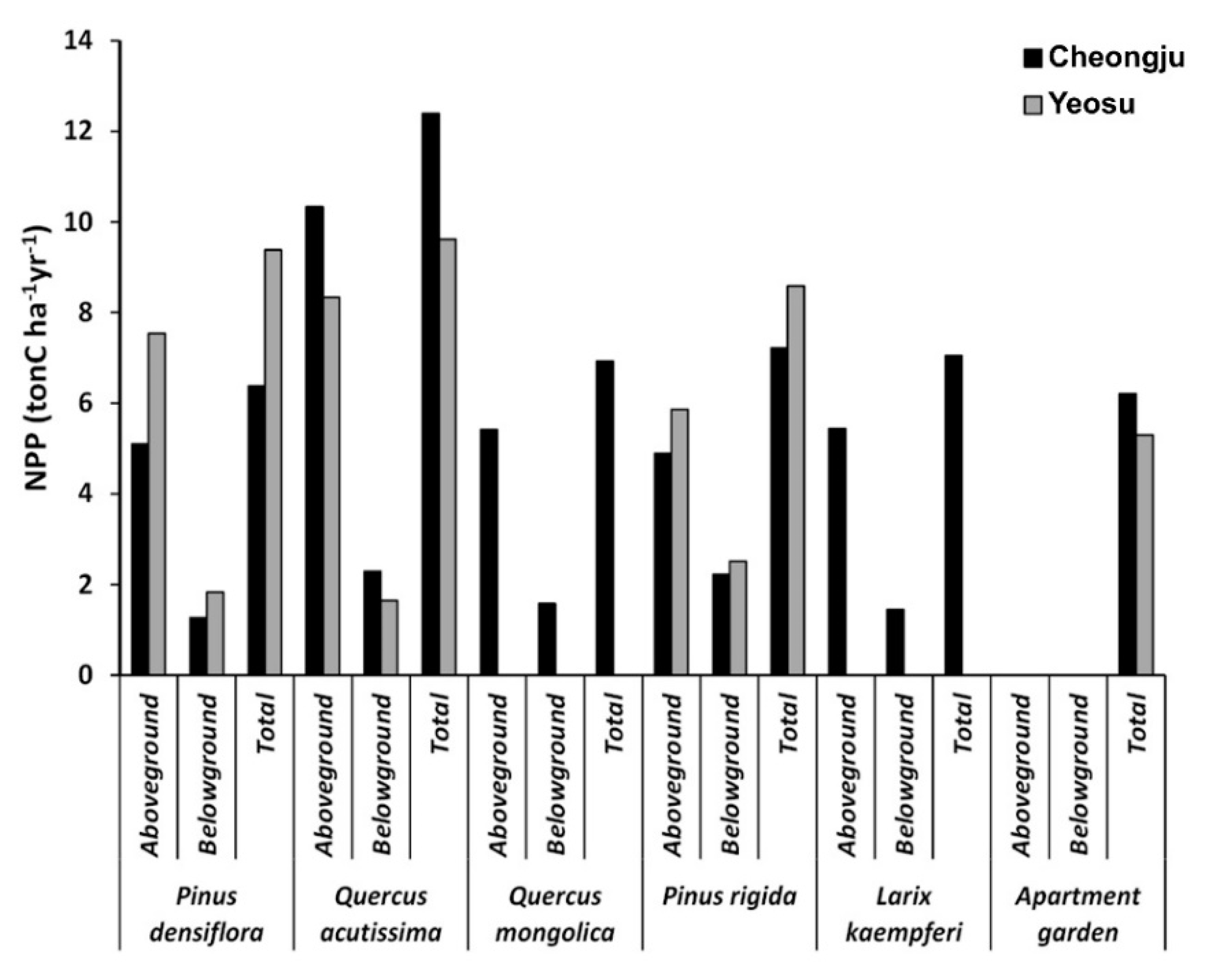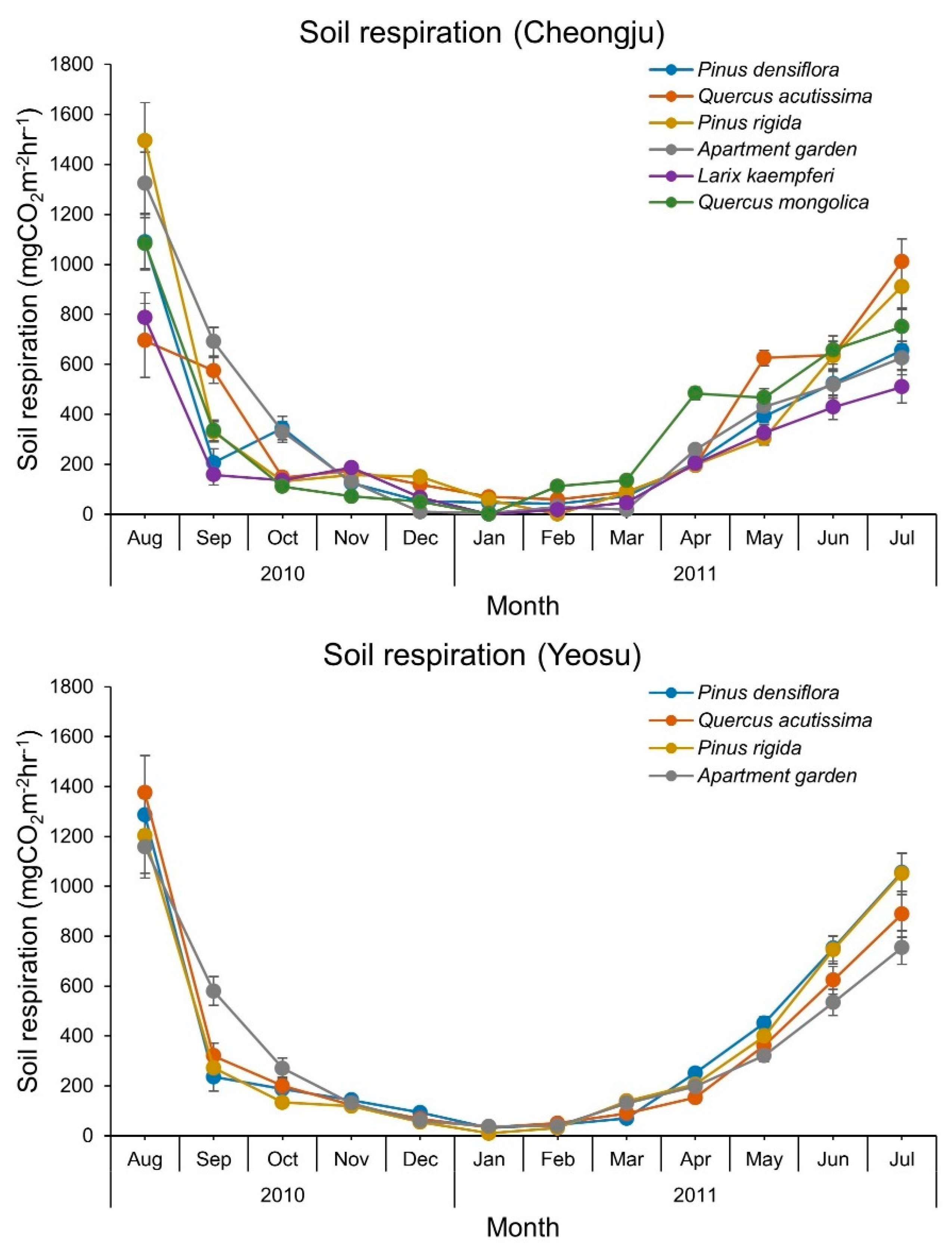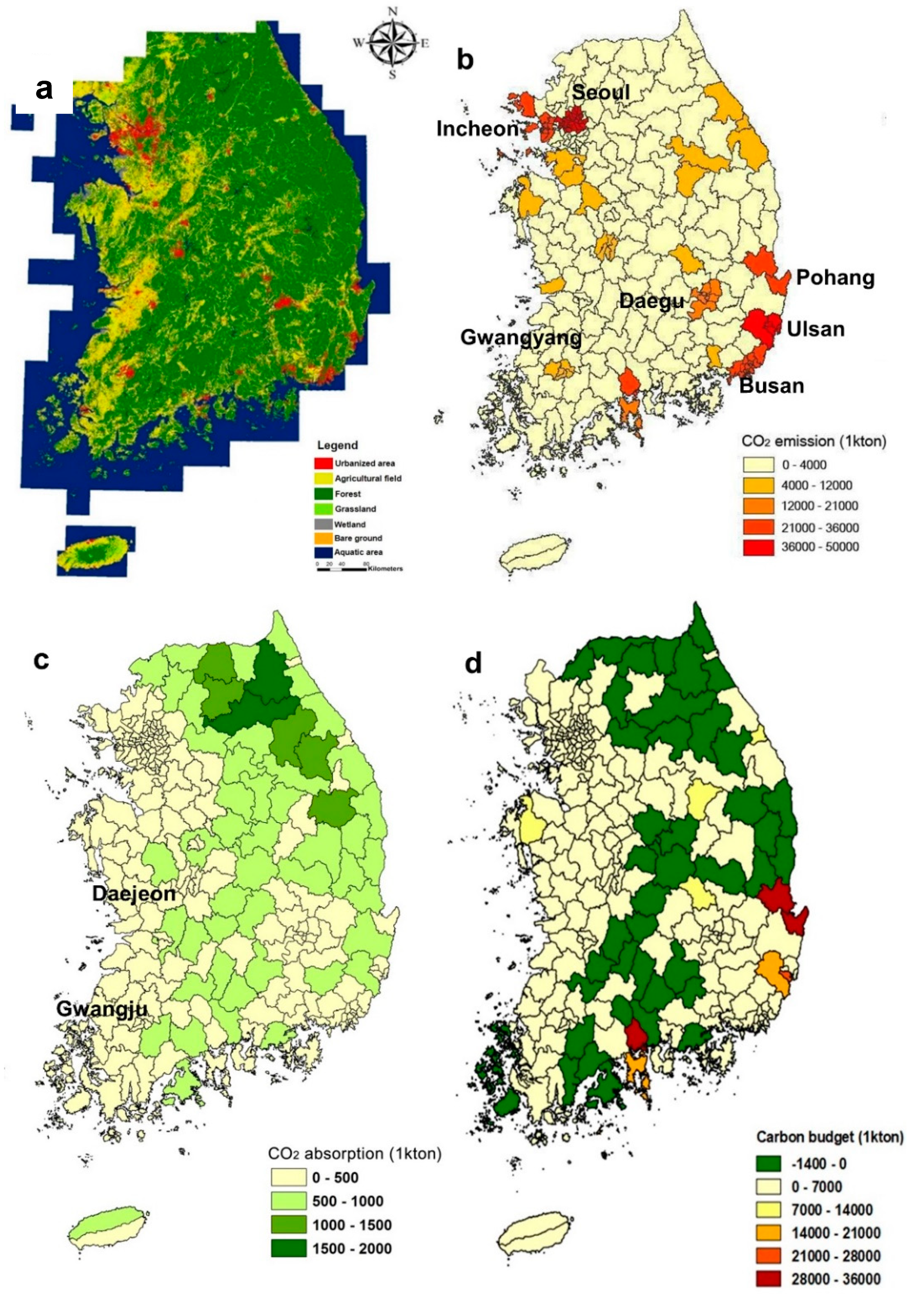Assessment of the Carbon Budget of Local Governments in South Korea
Abstract
:1. Introduction
2. Materials and Methods
2.1. Study Sites
2.2. Methods
2.2.1. Measurement of Net Primary Production
2.2.2. Measurement of Soil Respiration
2.2.3. Calculation of the Amount of Carbon Absorption by Local Government
2.2.4. Calculation of the Amount of Carbon Emissions by Local Government
2.2.5. Evaluation of the Carbon Budget of Local Government
3. Results
3.1. Net Primary Production (NPP)
3.2. Seasonal Changes in Soil Respiration and the Amount of Annual Soil Respiration
3.3. Net Ecosystem Production (NEP)
3.4. Carbon Emission by Local Government
3.5. Carbon Absorption by Local Government
3.6. Carbon Bdget
3.7. Relationship between the Carbon Budget and the Environmental Factor
4. Discussion
4.1. Carbon Dynamics
4.2. Carbon Budget and Environmental Sustainability
4.3. Strategies to Achieve Carbon Neutrality
5. Conclusions
Author Contributions
Funding
Institutional Review Board Statement
Informed Consent Statement
Data Availability Statement
Conflicts of Interest
References
- Cox, P.M.; Betts, R.A.; Jones, C.D.; Spall, S.A.; Totterdell, I.J. Acceleration of global warming due to carbon-cycle feedbacks in a coupled climate model. Nature 2000, 408, 184–187. [Google Scholar] [CrossRef]
- Prentice, I.C.; Farquhar, G.D.; Fasham, M.J.R.; Goulden, M.L.; Heimann, M.; Jaramillo, V.J.; Kheshgi, H.S.; Quéré, C.L.; Scholes, R.J.; Wallace, D.W.R.; et al. The carbon cycle and atmospheric carbon dioxide. In Climate Change 2001: The Scientific Basis, Intergovernmental Panel on Climate Change; IPCC: Geneva, Switzerland, 2001. [Google Scholar]
- Nakane, K. Quantitative evaluation of atmospheric CO2 sink into forest soils from the tropics to the boreal zone during the past three decades. Ecol. Res. 2001, 16, 671–685. [Google Scholar] [CrossRef]
- Joo, S.J.; Park, M.S.; Kim, G.S.; Lee, C.S. CO2 flux in a cool-temperate deciduous forest (Quercus mongolica) of Mt. Nam in Seoul, Korea. J. Ecol. Field Biol. 2011, 34, 95–106. [Google Scholar] [CrossRef] [Green Version]
- IPCC. Fourth Assessment Report of the Intergovernmental Panel on Climate Change, Climate Change 2007; Intergovernmental Panel on Climate Change: Cambridge, UK, 2007. [Google Scholar]
- Raich, J.W.; Schlesinger, W.H. The global carbon dioxide flux in soil respiration and its relationship to vegetation and climate. Tellus B 1992, 44, 81–99. [Google Scholar] [CrossRef] [Green Version]
- Bond-Lamberty, B.; Wang, C.; Gower, S.T. A global relationship between the heterotrophic and autotrophic components of soil respiration? Glob. Chang. Biol. 2004, 10, 1756–1766. [Google Scholar] [CrossRef]
- Schimel, D.S.; Wigley, T. The Carbon Cycle; Cambridge University Press: Cambridge, UK, 2000. [Google Scholar]
- Heimann, M.; Reichstein, M. Terrestrial ecosystem carbon dynamics and climate feedbacks. Nature 2008, 451, 289–292. [Google Scholar] [CrossRef] [PubMed]
- Hardy, J.T. Climate Change: Causes, Effects, and Solutions; John Wiley & Sons: West Sussex, UK, 2003. [Google Scholar]
- Joo, S.J.; Park, S.U.; Park, M.S.; Lee, C.S. Estimation of soil respiration using automated chamber systems in an oak (Quercus mongolica) forest at the Nam-San site in Seoul, Korea. Sci. Total Environ. 2012, 416, 400–409. [Google Scholar] [CrossRef]
- Kim, G.S.; Joo, S.J.; Lee, C.S. Seasonal Variation of Soil Respiration in the Mongolian Oak (Quercus mongolica Fisch. Ex Ledeb.) Forests at the Cool Temperate Zone in Korea. Forests 2020, 11, 984. [Google Scholar] [CrossRef]
- IPCC. A Report of Working Group of the Intergovernmental Panel on Climate Change, Climate Change 2001; Intergovernmental Panel on Climate Change: Cambridge, UK, 2001. [Google Scholar]
- Canadell, J.G.; Le Quéré, C.; Raupach, M.R.; Field, C.B.; Buitenhuis, E.T.; Ciais, P.; Conway, T.J.; Gillett, N.P.; Houghton, R.A.; Marland, G. Contributions to accelerating atmospheric CO2 growth from economic activity, carbon intensity, and efficiency of natural sinks. Proc. Natl. Acad. Sci. USA 2007, 104, 18866. [Google Scholar] [CrossRef] [Green Version]
- UNEP. Overview of the Republic of Korea’s Green Growth National Vision; United Nations Environment Programme: Nairobi, Kenya, 2009. [Google Scholar]
- Houghton, R.A. Land-use change and the carbon cycle. Glob. Change Biol. 1995, 1, 275–287. [Google Scholar] [CrossRef]
- IPCC. Climate Change 2014: Mitigation of Climate Change, Agriculture, Forestry and Other Land Use (AFOLU); Intergovernmental Panel on Climate Change: Cambridge, UK, 2014. [Google Scholar]
- The National Academy of Sciences and the Royal Society. Climate Change. Evidence & Causes. Update 2020; National Academy of Sciences and the Royal Society: Washington, DC, USA, 2020; p. 24. [Google Scholar]
- Paris Agreement. Paris agreement. In Proceedings of the Report of the Conference of the Parties to the United Nations Framework Convention on Climate Change, Bonn, Germany, 12 December 2015; p. 2017. [Google Scholar]
- Masson-Delmotte, V.; Zhai, P.; Pörtner, H.-O.; Roberts, D.; Skea, J.; Shukla, P.R.; Pirani, A.; Moufouma-Okia, W.; Péan, C.; Pidcock, R. Global Warming of 1.5 °C; Intergovernmental Panel on Climate Change: Geneva, Switzerland, 2018. [Google Scholar]
- Schimel, D.S. Terrestrial ecosystems and the carbon cycle. Glob. Change Biol. 1995, 1, 77–91. [Google Scholar] [CrossRef]
- Le Quéré, C.; Andrew, R.M.; Friedlingstein, P.; Sitch, S.; Hauck, J.; Pongratz, J.; Pickers, P.A.; Korsbakken, J.I.; Peters, G.P.; Canadell, J.G.; et al. Global Carbon Budget 2018. Earth Syst. Sci. Data 2018, 10, 2141–2194. [Google Scholar] [CrossRef] [Green Version]
- Candela, J.; Carlson, D. The Annual Global Carbon Budget. 2017. Available online: https://public.wmo.int/en/resources/bulletin/annual-global-carbon-budget (accessed on 15 December 2021).
- Friedlingstein, P.; O’Sullivan, M.; Jones, M.W.; Andrew, R.M.; Hauck, J.; Olsen, A.; Peters, G.P.; Peters, W.; Pongratz, J.; Sitch, S.; et al. Global Carbon Budget 2020. Earth Syst. Sci. Data 2020, 12, 3269–3340. [Google Scholar] [CrossRef]
- Nabuurs, G.J.; Masera, O.; Andrasko, K.; Benitez-Ponce, P.; Boer, R.; Dutschke, M.; Elsiddig, E.; Ford-Robertson, J.; Frumhoff, P.; Karjalainen, T.; et al. Forestry. In Climate Change 2007—Mitigation of Climate Change: Working Group III Contribution to the Fourth Assessment Report of the IPCC; Intergovernmental Panel on Climate; Cambridge University Press: Cambridge, UK, 2007; pp. 541–584. [Google Scholar]
- Rizvi, A.; Baig, S.; Barrow, E.; Kumar, C. Synergies between Climate Mitigation and Adaptation in Forest Landscape Restoration; IUCN: Gland, Switzerland, 2015. [Google Scholar]
- Son, Y.; Jun, Y.C.; Lee, Y.Y.; Kim, R.H.; Yang, S.Y. Soil Carbon Dioxide Evolution, Litter Decomposition, and Nitrogen Availability Four Years after Thinning in a Japanese Larch Plantation. Commun. Soil Sci. Plant Anal. 2004, 35, 1111–1122. [Google Scholar] [CrossRef]
- Kim, K.G.; Cho, D.G.; Kim, N.C.; Min, B.M. A study on the development of techniques for urban forest restoration and management-focus on the restoration of origin vegetation and improvement of biodiversity. J. Korean Soc. Environ. Restor. Technol. 2000, 3, 27–37. [Google Scholar]
- Kim, I.H.; Oh, K.S.; Jung, S.H. An analysis of relationship between carbon emission and urban spatial patterns. Spat. Inf. Res. 2011, 19, 61–72. [Google Scholar]
- Grübler, A. Technology and Global Change; Cambridge University Press: Cambridge, UK, 1994. [Google Scholar]
- Sheehan, M.O.M.; Peterson, J.A. Reinventing Cities for People and the Planet; Worldwatch Institute: Washington, DC, USA, 1999. [Google Scholar]
- IPCC. IPCC Special Report on Emissions Scenarios; Intergovernmental Panel on Climate Change: Cambridge, UK, 2000. [Google Scholar]
- Eggleston, H.S.; Buendia, L.; Miwa, K.; Ngara, T.; Tanabe, K. 2006 IPCC Guidelines for National Greenhouse Gas Inventories; IPCC: Hayama, Japan, 2006. [Google Scholar]
- Park, E.J.; Kang, K.Y. Estimation of C storage and annual CO2 uptake by street trees in Gyeonggi-do. Korean J. Environ. Ecol. 2010, 24, 591–600. [Google Scholar]
- Curtis, P.S.; Hanson, P.J.; Bolstad, P.; Barford, C.; Randolph, J.C.; Schmid, H.P.; Wilson, K.B. Biometric and eddy-covariance based estimates of annual carbon storage in five eastern North American deciduous forests. Agric. For. Meteorol. 2002, 113, 3–19. [Google Scholar] [CrossRef]
- Jo, H.K. Carbon uptake and emissions in urban landscape, and the role of urban greenspace for several cities in Kangwon Province. J. Korean Inst. Landsc. Archit. 1999, 27, 39–53. [Google Scholar]
- Kim, G.S.; Lim, Y.K.; An, J.H.; Lee, J.S.; Lee, C.S. Carbon budget in campus of the national institute of ecology. Korean J. Ecol. Environ. 2014, 47, 167–175. [Google Scholar] [CrossRef]
- Kim, G.S.; Pi, J.H.; An, J.H.; Lim, C.H.; Jung, S.H.; Joo, S.J.; Lee, C.S. Carbon Budget Evaluated in Two Urban Parks of Seoul. Korean J. Ecol. Environ. 2016, 49, 51–61. [Google Scholar] [CrossRef]
- Korea Meteorological Administration (KMA). Annual Climatological Report; Korea Meteorological Administration: Seoul, Korea, 2009.
- Whittaker, R.H.; Marks, P.L. Methods of assessing terrestrial productivity. In Primary Productivity of the Biosphere; Springer: Berlin/Heidelberg, Germany, 1975; pp. 55–118. [Google Scholar]
- Návar, J. Allometric equations for tree species and carbon stocks for forests of northwestern Mexico. For. Ecol. Manag. 2009, 257, 427–434. [Google Scholar] [CrossRef]
- Korea Forest Service (NIFS). Study on the Basis of Forest Carbon Accounting in Korea; Korea Forest Service: Seoul, Korea, 2010.
- Han, D.Y. Carbon Cycle Modeling by Litter Decomposition Rate and Estimation of Carbon Dioxide Budget in Quercus mongolica Forest at Mt. Songni National Park. Ph.D. Thesis, Chungbuk National University, Cheongju, Korea, 2002. [Google Scholar]
- Bekku, Y.; Koizumi, H.; Oikawa, T.; Iwaki, H. Examination of four methods for measuring soil respiration. Appl. Soil Ecol. 1997, 5, 247–254. [Google Scholar] [CrossRef]
- Raich, J.W.; Tufekciogul, A. Vegetation and soil respiration: Correlations and controls. Biogeochemistry 2000, 48, 71–90. [Google Scholar] [CrossRef]
- Lee, M.S. Method for Assessing Forest Carbon Sinks by Ecological Process-Based Approach-A Case Study for Takayama Station, Japan. Korean J. Ecol. 2003, 26, 289–296. [Google Scholar] [CrossRef]
- National Institute of Agricultural Sciences (NIAS). Test and Research Report; Rural Development Administration: Wanju, Korea, 1994.
- National Institute of Environmental Research (NIER). A Study on GHG-CAPSS Improvement Process; Ministory of Environment: Incheon, Korea, 2009.
- National Institute of Environmental Research (NIER). The Second Stage Report of KNLTER; Ministry of Environment: Incheon, Korea, 2010; p. 1258.
- Kim, S.K.; Jeong, J.Y. A Study on the Production Structure and Biomass Productivity of Quercus variabilis Natural Forest. J. Korean For. Soc. 1985, 70, 91–102. [Google Scholar]
- Song, C.Y.; Lee, S.W. Biomass and Net Primary Productivity in Natural Forests of Quercus mongolica and Quercus variabilis. J. Korean For. Soc. 1996, 85, 443–452. [Google Scholar]
- Park, G.S. Aboveground and Soil Carbon Storages in Quercus mongolica and Quercus variabilis Natural Forest Ecosystems in Chungju. J. Korean For. Soc. 1999, 88, 93–100. [Google Scholar]
- Luyssaert, S.; Inglima, I.; Jung, M.; Richardson, A.D.; Reichstein, M.; Papale, D.; Piao, S.L.; Schulze, E.D.; Wingate, L.; Matteucci, G.; et al. CO2 balance of boreal, temperate, and tropical forests derived from a global database. Glob. Change Biol. 2007, 13, 2509–2537. [Google Scholar] [CrossRef] [Green Version]
- Melillo, J.M.; McGuire, A.D.; Kicklighter, D.W.; Moore, B.; Vorosmarty, C.J.; Schloss, A.L. Global climate change and terrestrial net primary production. Nature 1993, 363, 234–240. [Google Scholar] [CrossRef]
- Son, Y.; Kim, H.W. Soil respiration in Pinus rigida and Larix leptolepis plantations. J. Korean Soc. For. Sci. 1996, 85, 496–505. [Google Scholar]
- Hwang, J.; Son, Y. Short-term effects of thinning and liming on forest soils of pitch pine and Japanese larch plantations in central Korea. Ecol. Res. 2006, 21, 671–680. [Google Scholar] [CrossRef]
- Prentice, I.C.; Farquhar, G.D.; Fasham, M.J.R.; Goulden, M.L.; Heimann, M.; Jaramillo, V.J.; Kheshgi, H.S.; Le Quéré, C.; Scholes, R.J.; Wallace, D.W.R.; et al. The carbon cycle and atmospheric carbon dioxide. In Climate Change 2001: The Scientific Basis. Contribution of Working Group I to the Third Assessment Report of the Intergovernmental Panel on Climate Change; Cambridge University Press: Cambridge, UK, 2001; Chapter 3; pp. 183–237. [Google Scholar]
- MEA. Ecosystems and Human Well-Being: Synthesis; World Resources Institute: Washington, DC, USA, 2005. [Google Scholar]
- Cohen-Shacham, E.; Walters, G.; Janzen, C.; Maginnis, S. Nature-Based Solutions to Address Global Societal Challenges; IUCN: Gland, Switzerland, 2016; p. 97. [Google Scholar]
- UNEP. Guidelines for Integrating Ecosystem-Based Adaptation into National Adaptation Plans: Supplement to the UNFCCC NAP Technical Guidelines; United Nations Environment Programme: Nairobi, Kenya, 2021. [Google Scholar]
- UN. The Sustainable Development Goals Report; United Nations: New York, NY, USA, 2019; p. 64. [Google Scholar]
- Lim, C.H.; Pi, J.H.; Kim, A.R.; Cho, H.J.; Lee, K.S.; You, Y.H.; Lee, K.H.; Kim, K.D.; Moon, J.S.; Lee, C.S. Diagnostic Evaluation and Preparation of the Reference Information for River Restoration in South Korea. Int. J. Environ. Res. Public Health 2021, 18, 1724. [Google Scholar] [CrossRef] [PubMed]
- Song, H.G.; Lee, C.S. Diagnosis on climate change: Climate change based on the flowering response of cherry tree. Clim. Chang. Ecol. Ser. Long Term Ecol. Res. 2014, 7, 60–74. [Google Scholar]
- Jung, S.H.; Kim, A.R.; An, J.H.; Lim, C.H.; Lee, H.; Lee, C.S. Abnormal shoot growth in Korean red pine as a response to microclimate changes due to urbanization in Korea. Int. J. Biometeorol. 2020, 64, 571–584. [Google Scholar] [CrossRef]
- Benton, T.G.; Bailey, R.; Froggatt, A.; King, R.; Lee, B.; Wellesley, L. Designing sustainable landuse in a 1.5 °C world: The complexities of projecting multiple ecosystem services from land. Curr. Opin. Environ. Sustain. 2018, 31, 88–95. [Google Scholar] [CrossRef]
- Kim, A.R.; Lim, B.S.; Seol, J.; Lee, C.S. Principle of restoration ecology reflected in the process creating the National Institute of Ecology. J. Ecol. Environ. 2021, 45, 12. [Google Scholar] [CrossRef]
- Hansen, J.; Sato, M.; Kharecha, P.; von Schuckmann, K.; Beerling, D.J.; Cao, J.; Marcott, S.; Masson-Delmotte, V.; Prather, M.J.; Rohling, E.J.; et al. Young people’s burden: Requirement of negative CO2 emissions. Earth Syst. Dyn. 2017, 8, 577–616. [Google Scholar] [CrossRef] [Green Version]
- Smith, P.; Davis, S.J.; Creutzig, F.; Fuss, S.; Minx, J.; Gabrielle, B.; Kato, E.; Jackson, R.B.; Cowie, A.; Kriegler, E.; et al. Biophysical and economic limits to negative CO2 emissions. Nat. Clim. Chang. 2016, 6, 42–50. [Google Scholar] [CrossRef] [Green Version]
- Galatowitsch, S.M. Carbon Offsets as Ecological Restorations. Restor. Ecol. 2009, 17, 563–570. [Google Scholar] [CrossRef]
- Evans, M.C.; Carwardine, J.; Fensham, R.J.; Butler, D.W.; Wilson, K.A.; Possingham, H.P.; Martin, T.G. Carbon farming via assisted natural regeneration as a cost-effective mechanism for restoring biodiversity in agricultural landscapes. Environ. Sci. Policy 2015, 50, 114–129. [Google Scholar] [CrossRef] [Green Version]
- IUCN. International Union for Conservation of Nature Annual Report 2016; IUCN: Gland, Switzerland, 2016. [Google Scholar]
- Hertog, C. Ecological Sustainability within California’s Improved Forest Management Carbon Offsets Program. Master’s Thesis, Clark University, Worcester, MA, USA, 2018. [Google Scholar]
- Dybala, K.E.; Matzek, V.; Gardali, T.; Seavy, N.E. Carbon sequestration in riparian forests: A global synthesis and meta-analysis. Glob. Change Biol. 2019, 25, 57–67. [Google Scholar] [CrossRef] [PubMed] [Green Version]
- Wanous, S. Carbon Offsets in San Diego County: An Analysis of Carbon Offset Policy Effectiveness, Best Practices, and Local Viability in the San Diego County Region; Institution of Oceanography: San Diego, CA, USA, 2019. [Google Scholar]
- Dave, R.; Saint-Laurent, C.; Murray, L.; Antunes Daldegan, G.; Brouwer, R.; de Mattos Scaramuzza, C.A.; Raes, L.; Simonit, S.; Catapan, M.; García Contreras, G. Second Bonn Challenge Progress Report; IUCN: Gland, Switzerland, 2018. [Google Scholar]
- The Government of the Republic of Korea (GRK). 2050 Carbon Neutral Strategy of the Republic of Korea; The Government of the Republic of Korea: Seoul, Korea, 2020.
- Lorenz, K.; Lal, R. Carbon dynamics and pools in major forest biomes of the world. In Carbon Sequestration in Forest Ecosystems; Springer: Dordrecht, The Netherlands, 2010; pp. 159–205. [Google Scholar]
- Lee, C.S.; Lee, H.; Kim, A.R.; Pi, J.H.; Bae, Y.J.; Choi, J.K.; Lee, W.S.; Moon, J.S. Ecological effects of daylighting and plant reintroduction to the Cheonggye Stream in Seoul, Korea. Ecol. Eng. 2020, 152, 105879. [Google Scholar] [CrossRef]
- Korean National Geographic Information Institute (KNGII). Korea National Spatial Data Infrastructure Portal. 2020. Available online: http://data.nsdi.go.kr/organization/a05016 (accessed on 15 December 2021).
- Naiman, R.J.; Decamps, H.; McClain, M.E. Riparia: Ecology, Conservation, and Management of Streamside Communities; Elsevier: Burlington, UK, 2010. [Google Scholar]
- Sutfin, N.A.; Wohl, E.E.; Dwire, K.A. Banking carbon: A review of organic carbon storage and physical factors influencing retention in floodplains and riparian ecosystems. Earth Surf. Processes Landf. 2016, 41, 38–60. [Google Scholar] [CrossRef]
- Matzek, V.; Stella, J.; Ropion, P. Development of a carbon calculator tool for riparian forest restoration. Appl. Veg. Sci. 2018, 21, 584–594. [Google Scholar] [CrossRef]
- Daigneault, A.J.; Eppink, F.V.; Lee, W.G. A national riparian restoration programme in New Zealand: Is it value for money? J. Environ. Manag. 2017, 187, 166–177. [Google Scholar] [CrossRef]
- O’Brien, J.M.; Warburton, H.J.; Graham, S.E.; Franklin, H.M.; Febria, C.M.; Hogsden, K.L.; Harding, J.S.; McIntosh, A.R. Leaf litter additions enhance stream metabolism, denitrification, and restoration prospects for agricultural catchments. Ecosphere 2017, 8, e02018. [Google Scholar] [CrossRef]
- Capon, S.J.; Chambers, L.E.; Mac Nally, R.; Naiman, R.J.; Davies, P.; Marshall, N.; Pittock, J.; Reid, M.; Capon, T.; Douglas, M.; et al. Riparian Ecosystems in the 21st Century: Hotspots for Climate Change Adaptation? Ecosystems 2013, 16, 359–381. [Google Scholar] [CrossRef]
- Knopf, F.L.; Johnson, R.R.; Rich, T.; Samson, F.B.; Szaro, R.C. Conservation of Riparian Ecosystems in the United States. Wilson Bull. 1988, 100, 272–284. [Google Scholar]
- Nilsson, C.; Berggren, K. Alterations of Riparian Ecosystems Caused by River Regulation: Dam operations have caused global-scale ecological changes in riparian ecosystems. How to protect river environments and human needs of rivers remains one of the most important questions of our time. BioScience 2000, 50, 783–792. [Google Scholar] [CrossRef]
- Perry, L.G.; Andersen, D.C.; Reynolds, L.V.; Nelson, S.M.; Shafroth, P.B. Vulnerability of riparian ecosystems to elevated CO2 and climate change in arid and semiarid western North America. Glob. Chang. Biol. 2012, 18, 821–842. [Google Scholar] [CrossRef]
- Rheinhardt, R.D.; Brinson, M.M.; Meyer, G.F.; Miller, K.H. Carbon storage of headwater riparian zones in an agricultural landscape. Carbon Balance Manag. 2012, 7, 4. [Google Scholar] [CrossRef] [PubMed] [Green Version]




| Community | NPP | Heterotrophic Respiration | NEP | |
|---|---|---|---|---|
| Cheongju | P. densiflora | 6.4 | 4.1 | 2.3 |
| P. rigida | 7.2 | 4.9 | 2.3 | |
| Q. acutissima | 12.4 | 4.8 | 7.6 | |
| L. kaempferi | 7.1 | 3.1 | 4.0 | |
| Q. mongolica | 6.9 | 4.7 | 2.2 | |
| Apartment garden | 6.2 | 4.8 | 1.4 | |
| Yeosu | P. densiflora | 9.4 | 6.7 | 2.7 |
| P. rigida | 8.6 | 4.6 | 4.0 | |
| Q. acutissima | 9.6 | 4.4 | 5.2 | |
| Apartment garden | 5.3 | 3.5 | 1.8 |
| Carbon Emission | Carbon Absorption | Carbon Budget | Population Size | Population Density | Coniferous Forest | Deciduous Forest | Total Forest Area | |
|---|---|---|---|---|---|---|---|---|
| Carbon absorption | −0.004 (0.948) | |||||||
| Carbon budget | 0.997 ** (0.000) | −0.087 (0.186) | ||||||
| Population size | 0.212 ** (0.001) | −0.405 ** (0.000) | 0.240 ** (0.000) | |||||
| Population density | −0.020 (0.763) | −0.440 ** (0.000) | 0.012 (0.787) | 0.666 ** (0.000) | ||||
| Coniferous forest area | −0.011 (0.868) | 0.844 ** (0.000) | −0.080 (0.217) | −0.435 ** (0.000) | −0.457 ** (0.000) | |||
| Broad-leaved forest area | 0.001 (0.996) | 0.956 ** (0.000) | −0.077 (0.231) | −0.343 ** (0.000) | −0.356 ** (0.000) | 0.673 ** (0.000) | ||
| Total forest area | −0.030 (0.656) | 0.679 ** (0.000) | −0.077 (0.185) | −0.451 ** (0.001) | −0.499 ** (0.000) | 0.627 ** (0.000) | 0.653 ** (0.000) | |
| Non-forest area | 0.030 (0.656) | −0.679 ** (0.000) | −0.077 (0.383) | 0.451 ** (0.001) | 0.499 ** (0.000) | −0.627 ** (0.000) | −0.653 ** (0.000) | −1.00 ** (0.000) |
| Environmental Factor | Carbon Budget (+) | Carbon Budget (−) |
|---|---|---|
| CO2 emission (ton) | 2,700,901.9 ± 4,630,635.9 | 411,696.0 ± 189,858.2 |
| CO2 absorption (ton) | 214,315.6 ± 233,222.5 | 787,068.6 ± 394,183.2 |
| Mean population size | 249,785.4 ± 213,288.2 | 38,485.9 ± 17,762.4 |
| Mean population density (individual/km2) | 47.7 ± 73.3 | 1.1 ± 1.5 |
| Mean forest ratio (%) | 32.3 ± 17.6 | 58.3 ± 11.7 |
Publisher’s Note: MDPI stays neutral with regard to jurisdictional claims in published maps and institutional affiliations. |
© 2022 by the authors. Licensee MDPI, Basel, Switzerland. This article is an open access article distributed under the terms and conditions of the Creative Commons Attribution (CC BY) license (https://creativecommons.org/licenses/by/4.0/).
Share and Cite
Kim, G.S.; Kim, A.R.; Lim, B.S.; Seol, J.; An, J.H.; Lim, C.H.; Joo, S.J.; Lee, C.S. Assessment of the Carbon Budget of Local Governments in South Korea. Atmosphere 2022, 13, 342. https://doi.org/10.3390/atmos13020342
Kim GS, Kim AR, Lim BS, Seol J, An JH, Lim CH, Joo SJ, Lee CS. Assessment of the Carbon Budget of Local Governments in South Korea. Atmosphere. 2022; 13(2):342. https://doi.org/10.3390/atmos13020342
Chicago/Turabian StyleKim, Gyung Soon, A Reum Kim, Bong Soon Lim, Jaewon Seol, Ji Hong An, Chi Hong Lim, Seung Jin Joo, and Chang Seok Lee. 2022. "Assessment of the Carbon Budget of Local Governments in South Korea" Atmosphere 13, no. 2: 342. https://doi.org/10.3390/atmos13020342
APA StyleKim, G. S., Kim, A. R., Lim, B. S., Seol, J., An, J. H., Lim, C. H., Joo, S. J., & Lee, C. S. (2022). Assessment of the Carbon Budget of Local Governments in South Korea. Atmosphere, 13(2), 342. https://doi.org/10.3390/atmos13020342






